Entropy Generation Optimization for Rarified Nanofluid Flows in a Square Cavity with Two Fins at the Hot Wall
Abstract
1. Introduction
2. Mathematical Modeling
2.1. Mathematical Formulation
2.2. Numerical Solution
2.3. Grid Independency
2.4. Code Verification
3. Results and Discussion
4. Conclusions
- As Kn increased, entropy generation decreased.
- For low Ra numbers, the entropy generation due to flow increased as ϕ increased.
- For higher Ra, the entropy generation due to flow decreased as ϕ increased.
- The entropy generation due to heat increased as both Ra and ϕ increase.
- A correlation model of the total entropy generation as a function of all the parameters investigated in this study was proposed.
- The conditions for the optimum (minimum) entropy generation in the investigated ranges of the parameters in this study were calculated mathematically and were validated numerically using CFD.
Author Contributions
Funding
Conflicts of Interest
Nomenclature
| Notations | |
| Ac | Cold wall area (m2) |
| Ah | Hot wall area (m2) |
| AF | Fin area (m2) |
| Be | Bejan number |
| Cp | Specific heat (J∙kg−1∙K−1) |
| G | Gravity acceleration in the x direction (m/s2) |
| h1 | Fin 1 Position (m) |
| h2 | Fin 2 Position (m) |
| h | Convection heat transfer coefficient |
| K | Thermal conductivity (W∙m−1∙K−1) |
| Kn | Knudsen number |
| Fluid thermal conductivity (W∙m−1∙K−1) | |
| Nanofluid thermal conductivity (W∙m−1∙K−1) | |
| Nano particles thermal conductivity (W∙m−1∙K−1) | |
| L | Length of the square cavity (m) |
| LF | Fin length (m) |
| Nu | Nusselt Number |
| P | Pressure (Pa) |
| Q | Heat transfer (W) |
| Local heat flux at the wall of the cold surface (W/m2) | |
| Local heat flux at the wall of the hot surface (W/m2) | |
| Local heat flux at the fin (W/m2) | |
| R | Universal gas constant (J/mol∙K) |
| Ra | Rayleigh number (gβ(T1-T2)L3/αν) |
| T | Temperature (°C) |
| Tc | Temperature of the first cell from the wall (°C) |
| Ti | Hot surface temperature (°C) |
| To | Cold surface temperature (°C) |
| Tg | Temperature of the nanofluid (°C) |
| Tw | Temperature of the wall (°C) |
| u | Velocity in x-direction (m/s) |
| uc | Tangential velocity of the first cell from the wall (m/s) |
| ug | Tangential velocity of the nanofluid (m/s) |
| uw | Tangential velocity of the wall (m/s) |
| V | Velocity in y-direction (m/s) |
| x, y | Cartesian coordinates [m) |
| Greek Symbols | |
| α | Thermal diffusivity (m2/s) |
| β | Thermal expansion coefficient (1/K) |
| γ | Specific weight (N/m3) |
| λ | Molecular mean free path (m) |
| μ | Dynamic viscosity (kg∙m−1∙s−1) |
| ν | Kinematic viscosity (m2∙s−1) |
| ϕ | Nano particles volume fraction (%) |
| ρ | Density of air, given by ideal gas equation (P/RT), (Kg/m3) |
| σT | Thermal accommodation coefficient |
| σv | Momentum accommodation coefficient |
| Subscripts | |
| Eff | Effective |
| f | Fluid |
| F | Fin |
| g | Gas flow |
| i | Hot wall |
| n | Normal |
| nf | Nanofluid |
| o | Cold wall |
| r | Ratio |
| w | Wall |
References
- Cai, J.; Zhang, L.; Ju, Y.; Pia, G.; Zhang, Z. An Introduction to Fractal-Based Approaches in Unconventional Reservoirs—Part I. Fractals 2018, 26, 1802001. [Google Scholar] [CrossRef]
- Xiao, B.; Zhang, X.; Wang, W.; Long, G.; Chen, H.; Kang, H.; Ren, W. A Fractal Model for Water Flow through Unsaturated Porous Rocks. Fractals 2018, 26, 1840015. [Google Scholar] [CrossRef]
- Xiao, B.; Chen, H.; Xiao, S.; Cai, J. Research on Relative Permeability of Nanofibers with Capillary Pressure Effect by Means of Fractal-Monte Carlo Technique. J. Nanosci. Nanotechnol. 2017, 17, 6811–6817. [Google Scholar] [CrossRef]
- Xiao, B.; Wang, W.; Fan, J.; Chen, H.; Hu, X.; Zhao, D.; Zhang, X.; Ren, W. Optimization of the Fractal-Like Architecture of Porous Fibrous Materials Related to Permeability, Diffusivity and Thermal Conductivity. Fractals 2017, 25, 1750030. [Google Scholar] [CrossRef]
- Shafieian, A.; Khiadani, M.; Nosrati, A. A review of latest developments, progress, and applications of heat pipe solar collectors. Renew. Sustain. Energy Rev. 2018, 95, 273–304. [Google Scholar] [CrossRef]
- Phiraphat, S.; Prommas, R.; Puangsombut, W. Experimental study of natural convection in PV roof solar collector. Int. Commun. Heat Mass Transf. 2017, 89, 31–38. [Google Scholar] [CrossRef]
- Liang, M.; Liu, Y.; Xiao, B.; Yang, S.; Wang, Z.; Han, H. An analytical model for the transverse permeability of gas diffusion layer with electrical double layer effects in proton exchange membrane fuel cells. Int. J. Hydrogen Energy 2018, 43, 17880–17888. [Google Scholar] [CrossRef]
- Long, G.; Liu, S.; Xu, G.; Wong, S.; Chen, H.; Xiao, B. A Perforation-Erosion Model for Hydraulic-Fracturing Applications. SPE Prod. Oper. 2018, 33, 770–783. [Google Scholar] [CrossRef]
- Long, G.; Xu, G. The Effects of Perforation Erosion on Practical Hydraulic-Fracturing Applications. SPE J. 2017, 22, 645–659. [Google Scholar] [CrossRef]
- Mey, G.D.; Torzewicz, T.; Kawka, P.; Czerwoniec, A.; Janicki, M.; Napieralski, A. Analysis of nonlinear heat exchange phenomena in natural convection cooled electronic systems. Microelectron. Reliab. 2016, 67, 15–20. [Google Scholar] [CrossRef]
- Purusothaman, A. Investigation of natural convection heat transfer performance of the QFN-PCB electronic module by using nanofluid for power electronics cooling applications. Adv. Powder Technol. 2018, 29, 996–1004. [Google Scholar] [CrossRef]
- Choi, S.U.S.; Eastman, J.A. Enhancing thermal conductivity of fluids with nanoparticles. In Proceedings of the ASME International Mechanical Engineering Congress & Exposition, San Francisco, CA, USA, 12–17 November 1995. [Google Scholar]
- Khanafer, K.; Vafai, K.; Lightstone, M. Bouyancy driven heat transfer enhancement in a two dimensional enclosure utilizing nanofluids. Int. J. Heat Mass Transf. 2003, 46, 3639–3653. [Google Scholar] [CrossRef]
- Khanafer, K.; Vafai, K. A critical synthesis of thermosphysical characteristics of nanofluids. Int. J. Heat Mass Transf. 2011, 54, 4410–4428. [Google Scholar] [CrossRef]
- Boungioron, J. Convective transport in nanofluids. ASME J. Heat Transf. 2006, 128, 240–250. [Google Scholar] [CrossRef]
- Oztop, H.F.; Abu-Nada, E. Numerical study of natural convection in partially heated rectangular enclosures filled with nanofluids. Int. J. Heat Fluid Flow 2008, 29, 1326–1336. [Google Scholar] [CrossRef]
- Ghasemi, B.; Aminossadati, S.M.; Raisi, A. Magnetic field effect on natural convection in a nanofluid-filled square enclosure. Int. J. Therm. Sci. 2011, 50, 1748–1756. [Google Scholar] [CrossRef]
- Kefayati, G.H.R.; Hosseinizadeh, S.F.; Gorji, M.; Sajjadi, H. Lattice Boltzmann simulation of natural convection in tall enclosures using water/SiO2 nanofluid. Int. Commun. Heat Mass Transf. 2011, 38, 798–805. [Google Scholar] [CrossRef]
- Kefayati, G.H.R. Heat transfer and entropy generation of natural convection on non-Newtonian nanofluids in porous cavity. Powder Technol. 2016, 299, 127–149. [Google Scholar] [CrossRef]
- Al-Kouz, W.; Alshare, A.; Kiwan, S.; Al-Muhtady, A.; Alkhalidi, A. Two-dimensional analysis of low-pressure flows in an inclined square cavity with two fins attached to the hot wall. Int. J. Therm. Sci. 2018, 126, 181–193. [Google Scholar] [CrossRef]
- Al-Kouz, W.; Kiwan, S.; Alkhalidi, A.; Sari, M.; Alshare, A. Numerical study of heat transfer enhancement for low-pressure flows in a square cavity with two fins attached to the hot wall using AL2O3-air nanofluid. J. Mech. Eng. 2018, 64, 26–36. [Google Scholar]
- Kefayati, G.H.R.; Che Sidik, N.A. Simulation of natural convection and entropy generation of non-Newtonian nanofluid in an inclined cavity using Buongiorno’s mathematical model (Part II, entropy generation). Powder Technol. 2017, 305, 679–703. [Google Scholar] [CrossRef]
- Parvin, S.; Chamkha, A.J. An analysis on free convection flow, heat transfer and entropy generation in an odd-shapped cavity filled with nanofluid. Int. Commun. Heat Mass Transf. 2014, 54, 8–17. [Google Scholar] [CrossRef]
- Mejri, I.; Mahmoudi, A.; Abbasi, M.A.; Omri, A. Magnetic field effect on entropy generation in a nanofluid-filled enclosure with sinusoidal heating on both side walls. Powder Technol. 2014, 266, 340–353. [Google Scholar] [CrossRef]
- Mahmoudi, A.; Mejri, I.; Abbasi, M.A.; Omri, A. Analysis of the entropy generation in nanofluid-filled cavity in the presence of magnetic field and uniform heat generation/absorption. J. Mol. Liq. 2014, 198, 63–77. [Google Scholar] [CrossRef]
- Armaghani, T.; Kasaeipoor, A.; Alavi, N.; Rashidi, M.M. Numerical investigation of water-alumina nanofluid natural convection heat transfer and entropy generation in a baffled L-shaped cavity. J. Mol. Liq. 2016, 223, 243–251. [Google Scholar] [CrossRef]
- Al-Zamily, A.M.J. Analysis of natural convection and entropy generation in a cavity filled with multi-layers of porous medium and nanofluid with a heat generation. Int. J. Heat Mass Transf. 2017, 106, 1218–1231. [Google Scholar] [CrossRef]
- Bouchoucha, A.E.M.; Bessaïh, R.; Oztop, H.F.; Al-Salem, K.; Bayrak, F. Natural convection and entropy generation in a nanofluid filled cavity with thick bottom wall: Effect of non-isothermal heating. Int. J. Mech. Sci. 2017, 126, 95–105. [Google Scholar] [CrossRef]
- Ashorynejad, H.R.; Hoseinpour, B. Investigation of different nanofluids effect on entropy generation on natural convection in porous cavity. Eur. J. Mech. B/Fluids 2017, 62, 86–93. [Google Scholar] [CrossRef]
- Sheremet, M.A.; Grosan, T.; Pop, I. Natural convection and entropy generation in a square cavity with variable temperature side walls filled with a nanofluid: Buongiorno’s mathematical model. Entropy 2017, 19, 337. [Google Scholar] [CrossRef]
- Alsabery, A.I.; Ishak, M.S.; Chamkha, A.J.; Hashim, I. Entropy Generation analysis and natural convection in a nanofluid-filled square cavity with a concentric solid insert and different temperature distributions. Entropy 2018, 20, 336. [Google Scholar] [CrossRef]
- Siavashi, M.; Yousofvand, R.; Rezanejad, S. Nanofluid and porous fins effect on natural convection and entropy generation of flow inside a cavity. Adv. Powder Technol. 2018, 29, 142–156. [Google Scholar] [CrossRef]
- Kashyap, D.; Dass, A.K. Two-phase lattice Boltzmann simulation of natural convection in a Cu-water nanofluid filled porous cavity: Effects of thermal boundary conditions on heat transfer and entropy generation. Adv. Powder Technol. 2018, 29, 2707–2724. [Google Scholar] [CrossRef]
- Gibanov, N.S.; Sheremet, M.A.; Oztop, H.F.; Abu-Hamdeh, N. Mixed convection with entropy generation of nanofluid in a lid-driven cavity under the effects of a heat-conducting solid wall and vertical temperature gradient. Eur. J. Mech. B Fluids 2018, 70, 148–159. [Google Scholar] [CrossRef]
- Mansour, M.A.; Siddiqa, S.; Gorla, R.S.R.; Rashad, A.M. Effect of heat source and sink on entropy generation and MHD natural convection of Al2O3-Cu/water hybrid nanofluid filled with square porous cavity. Therm. Sci. Eng. Prog. 2018, 6, 57–71. [Google Scholar] [CrossRef]
- Rahimi, A.; Sepehr, M.; Lariche, M.J.; Kasaeipoor, A.; Malekshah, E.H. Entropy generation analysis and heatline visualization of free convection in nanofluid (KKL model-based)—Filled cavity including internal active fins using lattice Boltzmann method. Comput. Math. Appl. 2018, 75, 1814–1830. [Google Scholar] [CrossRef]
- Rashidi, M.M.; Nasiri, M.; Shadloo, M.S.; Yang, Z. Entropy Generation in a Circular Tube Heat Exchanger Using Nanofluids: Effects of Different Modeling Approaches. Heat Transf. Eng. 2016, 38, 853–866. [Google Scholar] [CrossRef]
- Yarmand, H.; Ahmadi, G.; Gharehkhani, S.; Kazi, S.; Safaei, M.; Alehashem, M.; Mahat, A. Entropy Generation during Turbulent Flow of Zirconia-water and Other Nanofluids in a Square Cross Section Tube with a Constant Heat Flux. Entropy 2014, 16, 6116–6132. [Google Scholar] [CrossRef]
- Jamalabadi, M.A.; Safaei, M.; Alrashed, A.; Nguyen, T.; Filho, E.B. Entropy Generation in Thermal Radiative Loading of Structures with Distinct Heaters. Entropy 2017, 19, 506. [Google Scholar] [CrossRef]
- Aghaei, A.; Sheikhzadeh, G.A.; Goodarzi, M.; Hasani, H.; Damirchi, H.; Afrand, M. Effect of horizontal and vertical elliptic baffles inside an enclosure on the mixed convection of a MWCNTs-water nanofluid and its entropy generation. Eur. Phys. J. Plus 2018, 133, 486. [Google Scholar] [CrossRef]
- Mahmoudinezhad, S.; Rezania, A.; Yousefi, T.; Shadloo, M.S.; Rosendahl, L.A. Adiabatic partition effect on natural convection heat transfer inside a square cavity: Experimental and numerical studies. Heat Mass Transf. 2017, 54, 291–304. [Google Scholar] [CrossRef]
- Nasiri, H.; Jamalabadi, M.Y.; Sadeghi, R.; Safaei, M.R.; Nguyen, T.K.; Shadloo, M.S. A smoothed particle hydrodynamics approach for numerical simulation of nano-fluid flows. J. Therm. Anal. Calorim. 2018. [Google Scholar] [CrossRef]
- Karniadakis, G.; Beskok, A.; Aluru, N. Microflows and Nanoflows; Springer: Berlin, Germany, 2005. [Google Scholar]
- Lockerby, D.; Reese, J.; Barber, R. Velocity boundary condition at solid wall in rarefied gas calculations. Phys. Rev. E 2004, 70, 017303. [Google Scholar] [CrossRef] [PubMed]
- Colin, S. Heat Transfer and Fluid Flow in Minichannels and Microchannels: Single-Phase Gas Flow in Microchannels; Elsevier: Amsterdam, The Netherlands, 2006. [Google Scholar]
- Versteeg, H.; Malalasekera, W. An Introduction to Computational Fluid Dynamics: The Finite Volume Method; Prentice-Hall: Upper Saddle River, NJ, USA, 1995. [Google Scholar]
- Patankar, S.V.; Spalding, D.B. A calculation procedure for heat, mass and momentum transfer in three-dimensional parabolic flows. Int. J. Heat Mass Transf. 1972, 15, 1787–1806. [Google Scholar] [CrossRef]
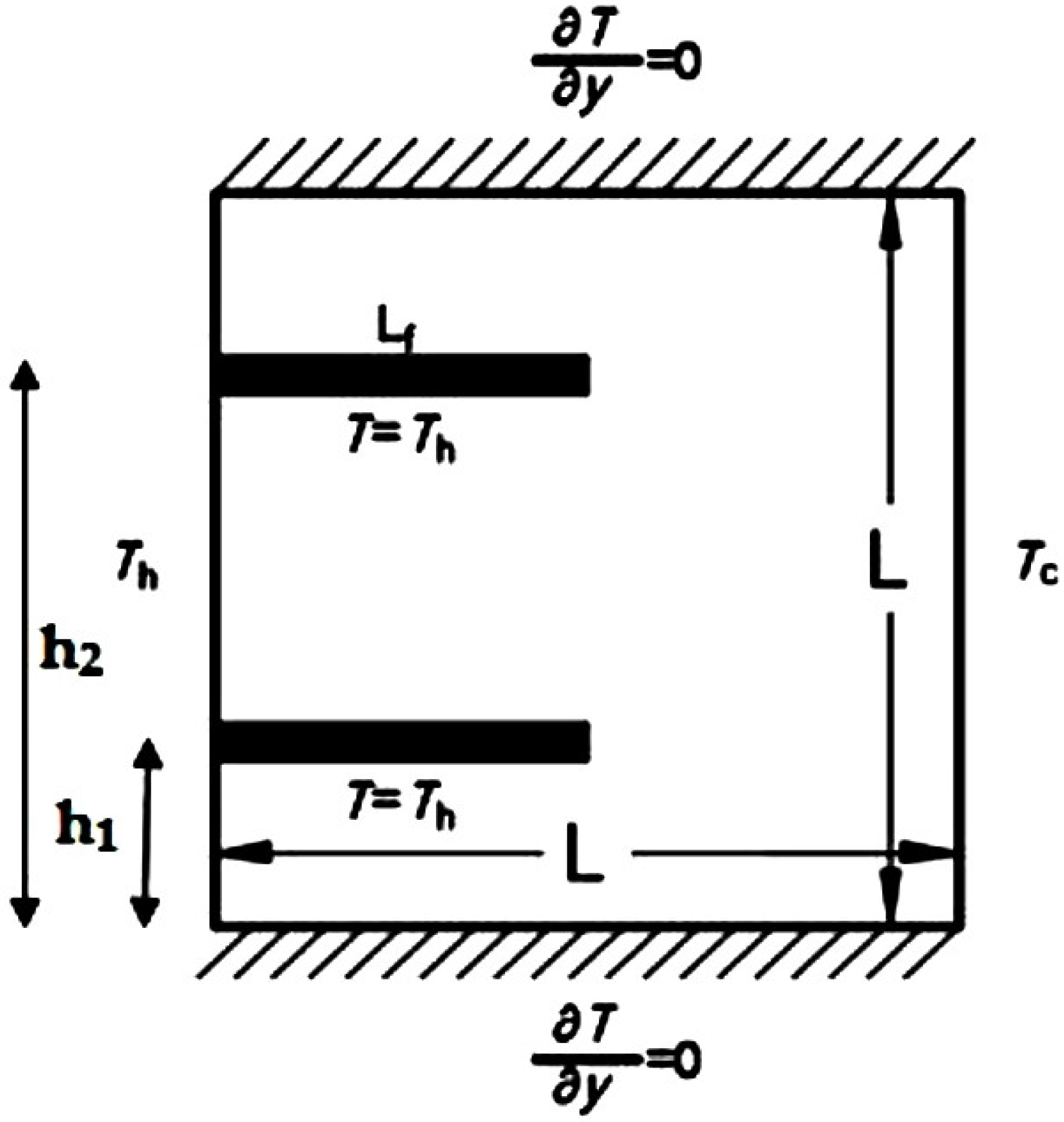



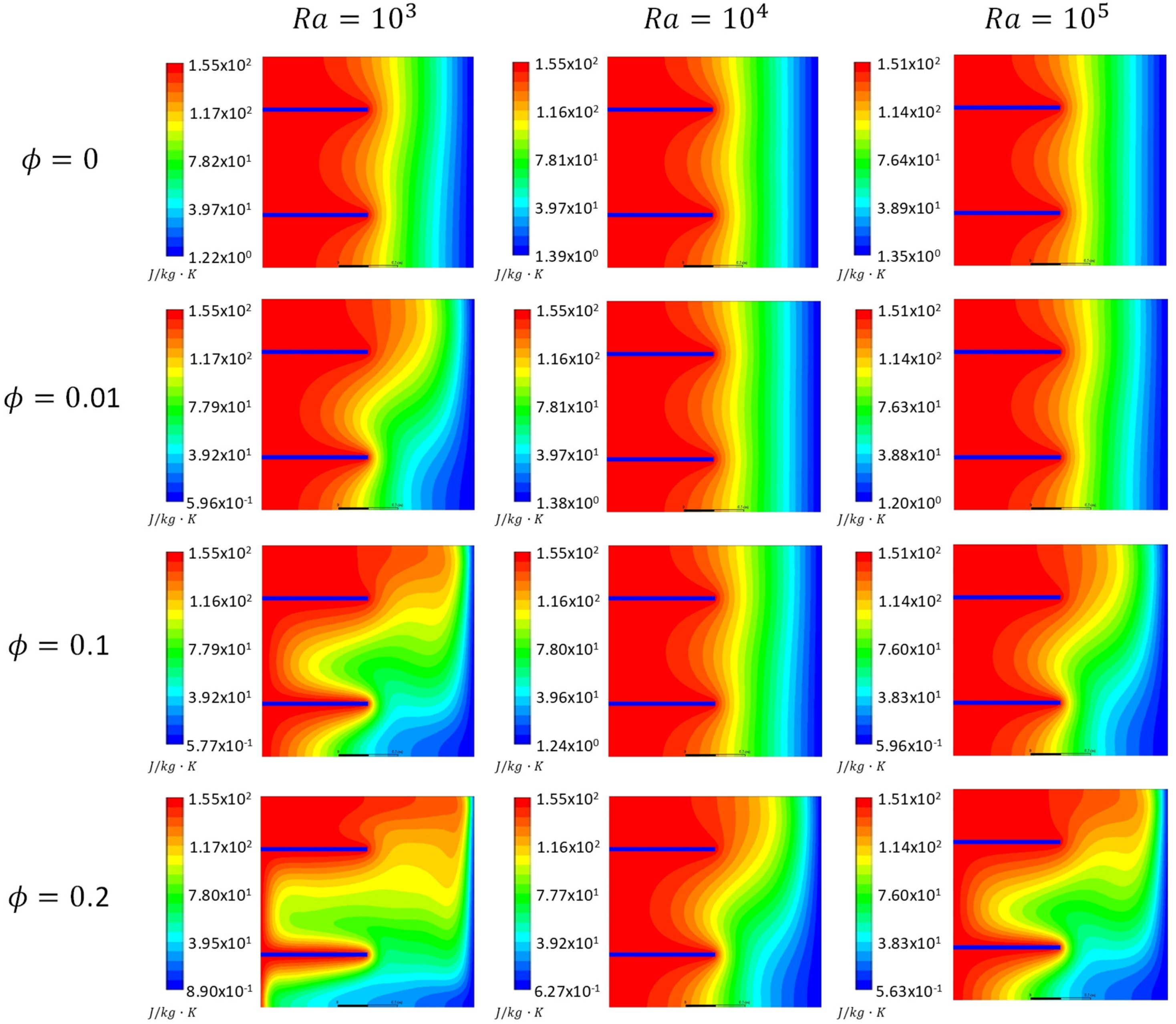

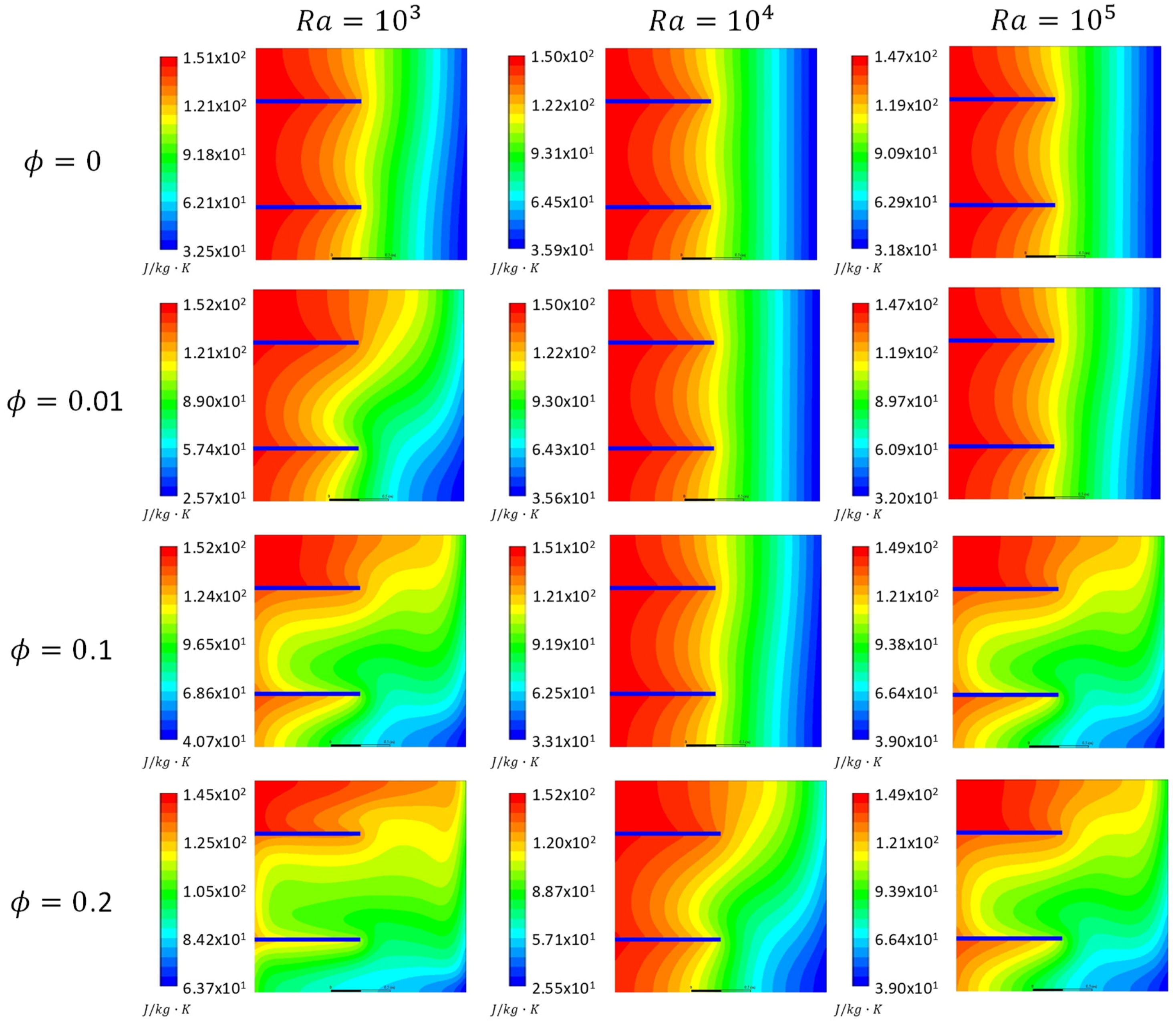

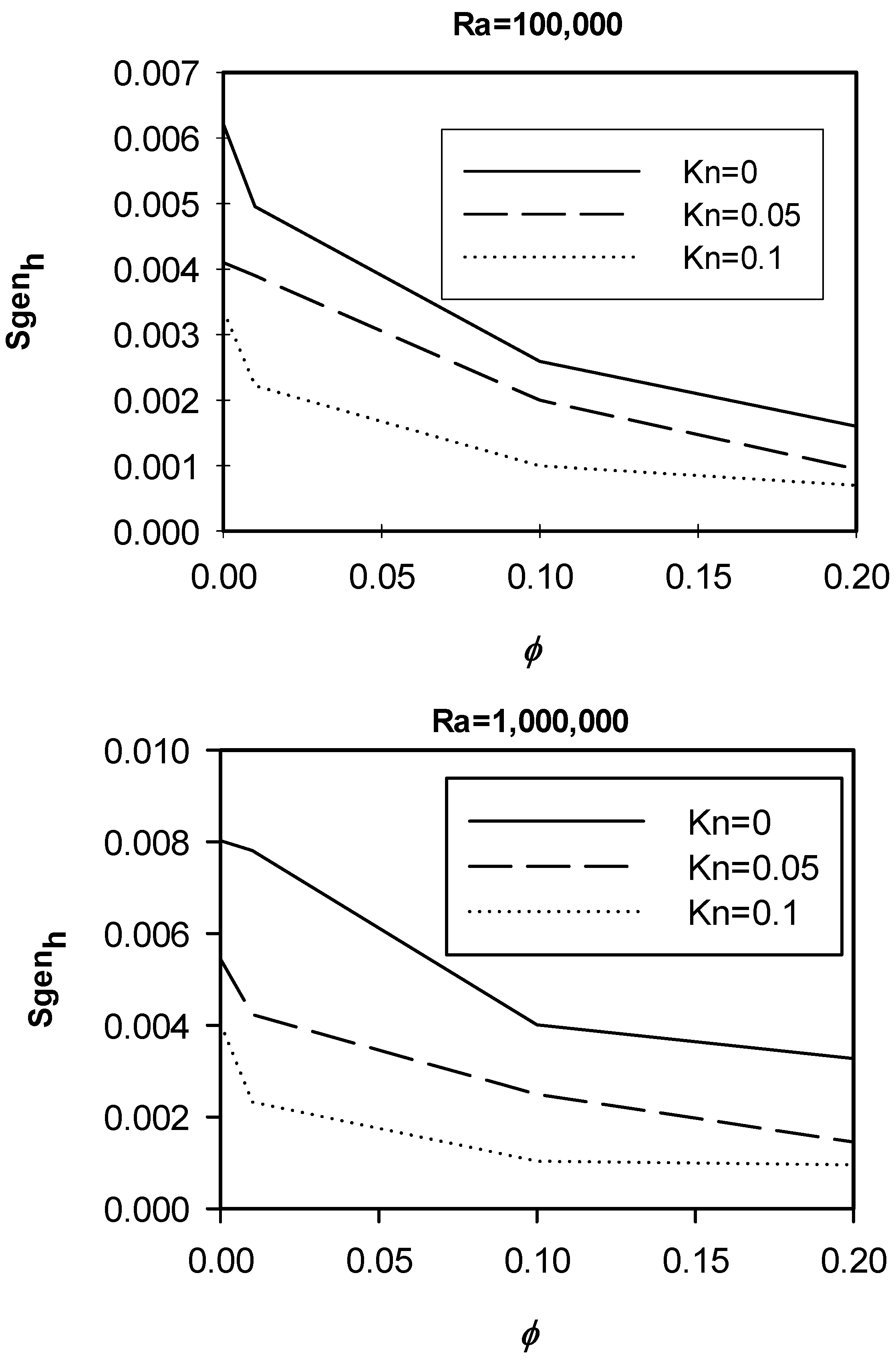
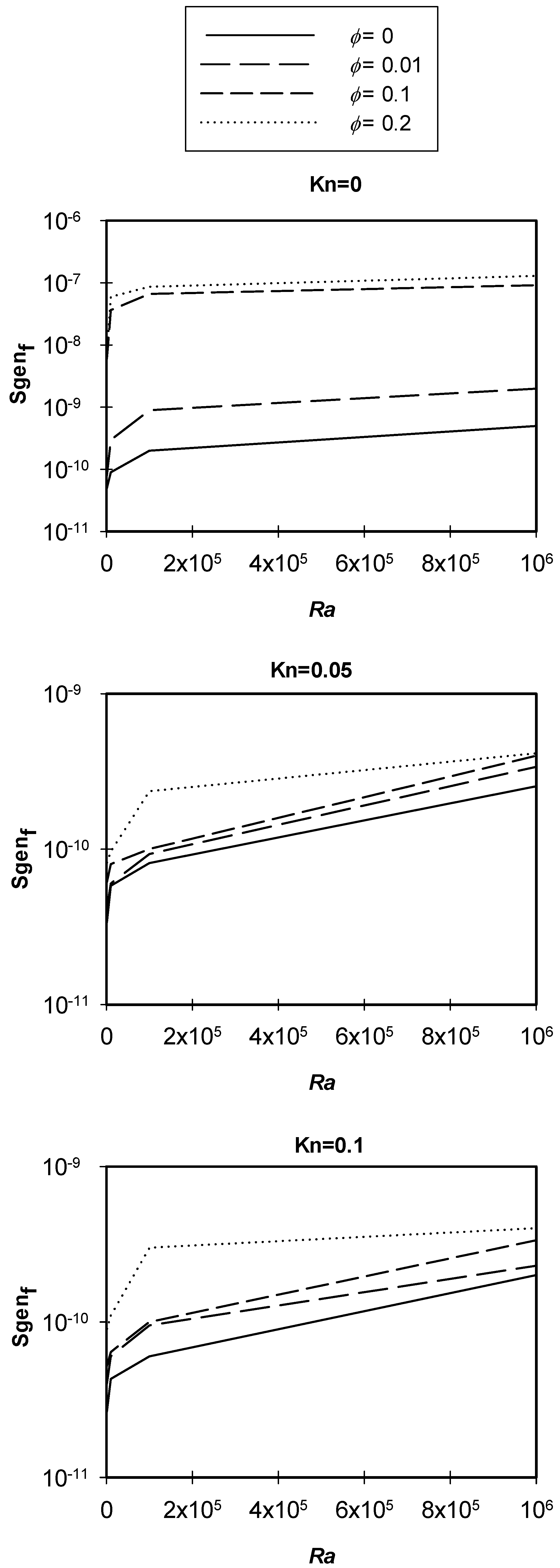





| Physical Properties | Air | Al2O3 |
|---|---|---|
| Cp (J/kg∙K) | 1006.43 | 765 |
| ρ (kg/m3) | 1 | 3970 |
| k (W/m2∙K) | 0.025 | 40 |
| β (1/K) | 0.00333 | 0.0000085 |
| α (m2/s) | 0.000019 | 0.00001317 |
| Mesh Size | Average Velocity (m/s) | Relative Error in the Average Velocity (%) | Nu | Relative Error in Nu (%) | Simulation Time (s) |
|---|---|---|---|---|---|
| 40 × 40 | 0.00055464421 | 0.050516 | 5.0973 | 0.044250507 | 415 |
| 60 × 60 | 0.00057143194 | 0.021778 | 4.9694 | 0.01804847 | 622 |
| 80 × 80 | 0.00057617336 | 0.013661 | 4.9157 | 0.00704730 | 739 |
| 100 × 100 | 0.00058415352 | 0.0 | 4.8813 | 0.0 | 823 |
| 120 × 120 | 0.00058415352 | 0.0 | 4.881297 | 6.15 × 10−7 | 876 |
© 2019 by the authors. Licensee MDPI, Basel, Switzerland. This article is an open access article distributed under the terms and conditions of the Creative Commons Attribution (CC BY) license (http://creativecommons.org/licenses/by/4.0/).
Share and Cite
Al-Kouz, W.; Al-Muhtady, A.; Owhaib, W.; Al-Dahidi, S.; Hader, M.; Abu-Alghanam, R. Entropy Generation Optimization for Rarified Nanofluid Flows in a Square Cavity with Two Fins at the Hot Wall. Entropy 2019, 21, 103. https://doi.org/10.3390/e21020103
Al-Kouz W, Al-Muhtady A, Owhaib W, Al-Dahidi S, Hader M, Abu-Alghanam R. Entropy Generation Optimization for Rarified Nanofluid Flows in a Square Cavity with Two Fins at the Hot Wall. Entropy. 2019; 21(2):103. https://doi.org/10.3390/e21020103
Chicago/Turabian StyleAl-Kouz, Wael, Ahmad Al-Muhtady, Wahib Owhaib, Sameer Al-Dahidi, Montasir Hader, and Rama Abu-Alghanam. 2019. "Entropy Generation Optimization for Rarified Nanofluid Flows in a Square Cavity with Two Fins at the Hot Wall" Entropy 21, no. 2: 103. https://doi.org/10.3390/e21020103
APA StyleAl-Kouz, W., Al-Muhtady, A., Owhaib, W., Al-Dahidi, S., Hader, M., & Abu-Alghanam, R. (2019). Entropy Generation Optimization for Rarified Nanofluid Flows in a Square Cavity with Two Fins at the Hot Wall. Entropy, 21(2), 103. https://doi.org/10.3390/e21020103





